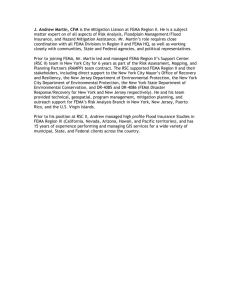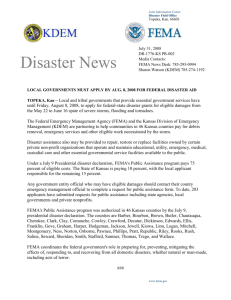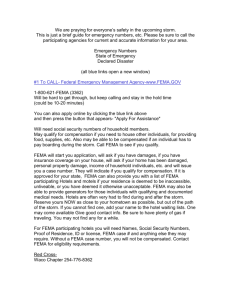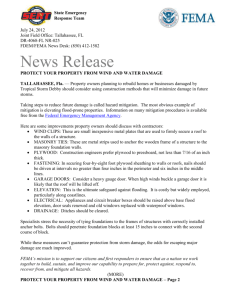Recovery Efforts Related to Schools and Students
advertisement
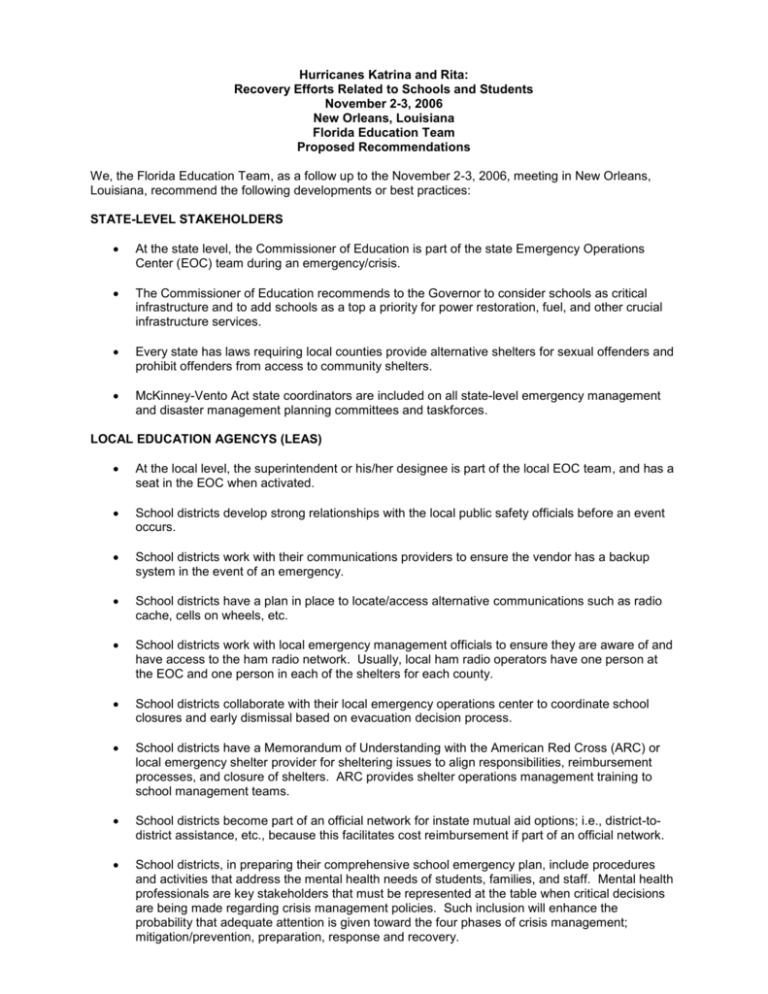
Hurricanes Katrina and Rita: Recovery Efforts Related to Schools and Students November 2-3, 2006 New Orleans, Louisiana Florida Education Team Proposed Recommendations We, the Florida Education Team, as a follow up to the November 2-3, 2006, meeting in New Orleans, Louisiana, recommend the following developments or best practices: STATE-LEVEL STAKEHOLDERS At the state level, the Commissioner of Education is part of the state Emergency Operations Center (EOC) team during an emergency/crisis. The Commissioner of Education recommends to the Governor to consider schools as critical infrastructure and to add schools as a top a priority for power restoration, fuel, and other crucial infrastructure services. Every state has laws requiring local counties provide alternative shelters for sexual offenders and prohibit offenders from access to community shelters. McKinney-Vento Act state coordinators are included on all state-level emergency management and disaster management planning committees and taskforces. LOCAL EDUCATION AGENCYS (LEAS) At the local level, the superintendent or his/her designee is part of the local EOC team, and has a seat in the EOC when activated. School districts develop strong relationships with the local public safety officials before an event occurs. School districts work with their communications providers to ensure the vendor has a backup system in the event of an emergency. School districts have a plan in place to locate/access alternative communications such as radio cache, cells on wheels, etc. School districts work with local emergency management officials to ensure they are aware of and have access to the ham radio network. Usually, local ham radio operators have one person at the EOC and one person in each of the shelters for each county. School districts collaborate with their local emergency operations center to coordinate school closures and early dismissal based on evacuation decision process. School districts have a Memorandum of Understanding with the American Red Cross (ARC) or local emergency shelter provider for sheltering issues to align responsibilities, reimbursement processes, and closure of shelters. ARC provides shelter operations management training to school management teams. School districts become part of an official network for instate mutual aid options; i.e., district-todistrict assistance, etc., because this facilitates cost reimbursement if part of an official network. School districts, in preparing their comprehensive school emergency plan, include procedures and activities that address the mental health needs of students, families, and staff. Mental health professionals are key stakeholders that must be represented at the table when critical decisions are being made regarding crisis management policies. Such inclusion will enhance the probability that adequate attention is given toward the four phases of crisis management; mitigation/prevention, preparation, response and recovery. School districts include in their school emergency management and disaster management planning for schools and school district staff, training and awareness activities regarding rights and responsibilities under the No Child Left Behind (NCLB) Title X, McKinney-Vento Rights for Homeless Children Act. McKinney-Vento Act School District Homeless Education Liaisons are included on all emergency management and disaster management planning committees and taskforces for schools and school districts. School Districts should ensure the staff person(s) charged with emergency management responsibilities have received the appropriate technical and professional training to carry out such responsibilities. U.S DEPARTMENT OF EDUCATION (USDOE) The USDOE facilitates the development of interstate agreements between states to share student data across state lines and also to address information for private schools prior to an emergency occurring. The USDOE, in concert with FEMA, takes the lead in forming a National Emergency Recovery Network comprised of regional teams and develops training for National Emergency Recovery Teams modeled after Escambia County's Emergency Recovery Team, as well as utilizing other models such as NOVA. The USDOE continues to sponsor nationwide Emergency Management Planning meetings, with both state and local representation on teams, that specifically concentrate on one major emergency functions at a time such as transportation, food services, finance, facilities, student services, emergency planning, McKinney Vento, etc. The USDOE discusses with the Federal Emergency Management Agency (FEMA) the proposed recommendations in this document and follows up with meeting participants as to FEMA’s response. FEDERAL EMERGENCY MANAGEMENT AGENCY (FEMA) FEMA improves the claims process for school districts by providing standardized damage assessment packets to affected school districts and assigns one FEMA liaison or "buddy", which can communicate with ALL levels of the FEMA organization, to affected districts for the duration of the FEMA claims process. FEMA provides training for its personnel on the role of the Local Education Agency Homeless Liaison in providing access to services and preserving the educational rights of homeless children. FEMA adds a “Consent to Share Information with the Local Educational Agency (LEA) Statement” on the FEMA Confidentiality Form for families with school-age children. The statement would authorize FEMA to exchange information related to student(s) with the LEA that may provide academic services. The information exchanged could be used to provide education, transportation, nutrition, medical, and welfare management services in the best interests of the student. FEMA communicates to citizens that before, during, and after disasters the best donations are gift cards to major stores within the geographic region such as a retail/clothing/shoe/discount stores, home improvement stores, gasoline stations, grocery stores, etc.

